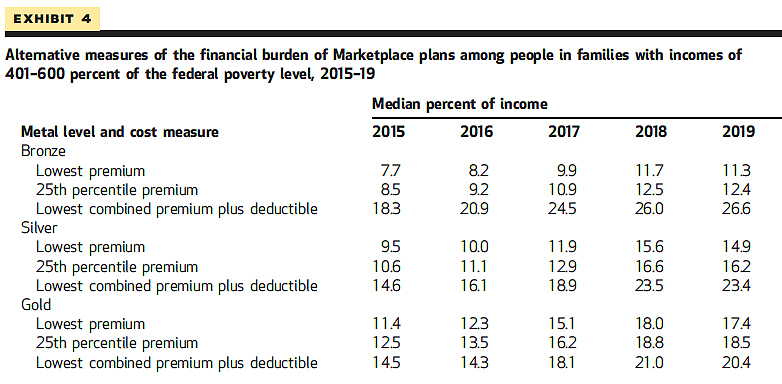A new Health Justice Monitor commentary on the
increasing costs of Marketplace plans for near-elderly middle class families.
By James G. Kahn, MD/MPH
Summary
The Affordable Care Act uses private plan Marketplaces and tax subsidies to try to make insurance affordable for middle class families. New research shows that from 2015-2019, low cost Bronze plans increased in net cost, with combined premiums and deductibles reaching 26.6% of median income. ACA financial protections, already weak, are eroding.
Excerpt
Health Affairs, November 2021, By Paul D. Jacobs and Steven C. Hill
As a measure of affordability, we calculated potential [Affordable Care Act] Marketplace premiums as a percentage of family income among families with incomes of 401– 600 percent of poverty. In 2015 half of this middle-class population would have paid at least 7.7 percent of their income for the lowest-cost bronze plan; in 2019 they would have paid at least 11.3 percent of their income. By 2019 half of the near-elderly ages 55–64 would have paid at least 18.9 percent of their income for the lowest-cost bronze plan in their area. The American Rescue Plan Act temporarily expanded tax credit eligibility for 2021 and 2022, but our results suggest that families with incomes of 401–600 percent of poverty will again face substantial financial burdens after the temporary subsidies expire.
Commentary
A major element of the Affordable Care Act (ACA) was to establish “Marketplaces” or “Exchanges” to facilitate access to regulated private insurance plans for the middle class – those earning too much to qualify for Medicaid, lacking workplace insurance, and not wealthy enough to go it alone.
This strategy has a number of problems. It’s inefficient, just like (even more than) all private health insurance, with administrative and profit costs. It’s a government hand-out to private insurers – after all, the subsidy is really to the insurers, passing through the insured. And the plan designs are flawed, with inconsistent coverage rules and for low-cost plans (Bronze especially) consistently high deductibles.
This new research shows that initially (2015) for families at 400-600% of the Federal Poverty Level (currently $69,680–$104,520 for a family of two), the premium represented 7.7% of income for a Bronze plan, and this reached 18.3% when including the deductible – potentially a significant financial burden and barrier to care. By 2019, these costs rose to 11.3% and 26.6% of income, respectively. For those 55-64 years old, the premium alone is now 18.9% of income.
Sorry for the deluge of geeky percentages. They reflect real financial barriers to insurance and to medical care. The fact that the portion of income is substantial and increasing should add to evidence that the ACA is a flawed overlay patch to our fundamentally dysfunctional health insurance system.
It’s time to end the overlay patches, and adopt a simple, direct, understandable, efficient, and equitable system, one that has been demonstrated to work in dozens of countries around the world. Single payer.
—Jim Kahn, MD
Subscribe to Health Justice Monitor
The McCanne Health Justice Monitor (HJM) is a health policy blog focused on the U.S. health system failings and single payer reform. A core team of health policy experts and guest contributors write posts several times per month, addressing topics ranging from healthcare inequity and waste, distortions introduced by profit motives, racism and racial inequities in health care, climate and environmental justice, global health and more.
HEAL California is an independent news and information hub focused on the Medicare for All movement.
With non-partisan news, views, podcasts and videos, we highlight the on-going injustices of our broken healthcare system and amplify the voices of those who are most impacted by it.
Our Podcasts shine a light on the failures of America’s healthcare system, while explaining how Medicare for All could help.
Our Media page offers connections to experts and additional resources including links to legislation and studies.
Keep up with the Medicare for All movement!
Follow us on Facebook and Twitter, and subscribe for email updates.

